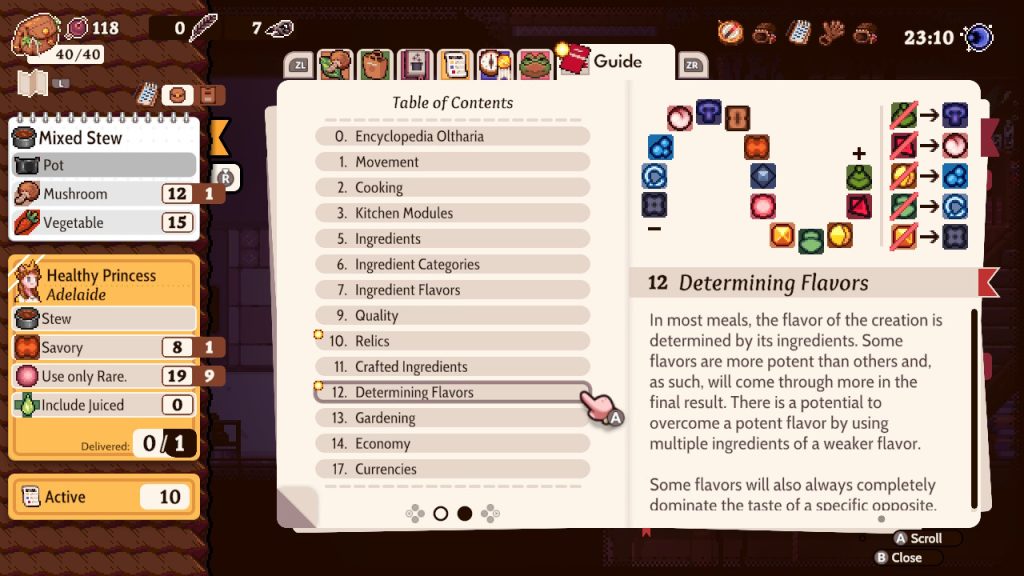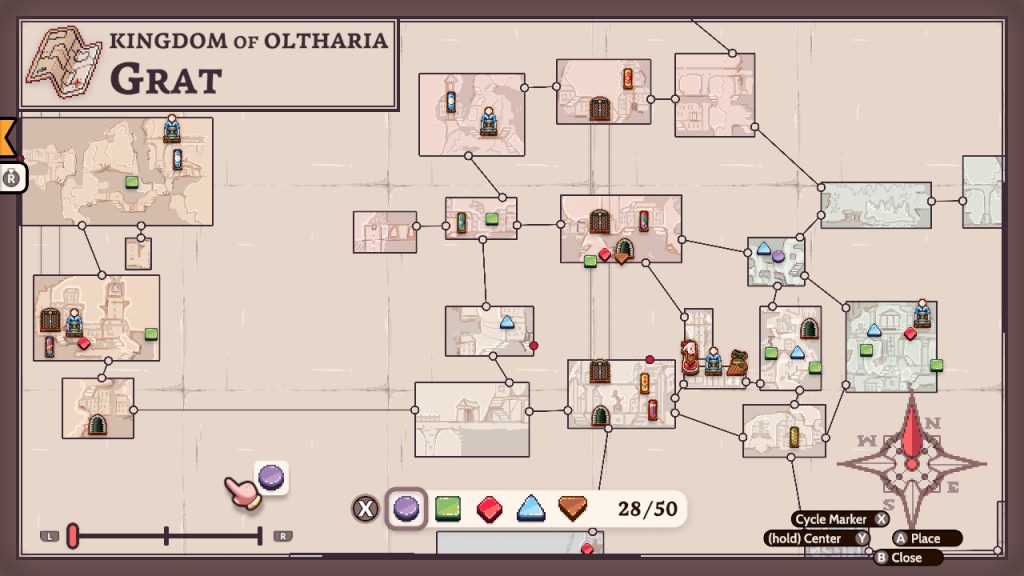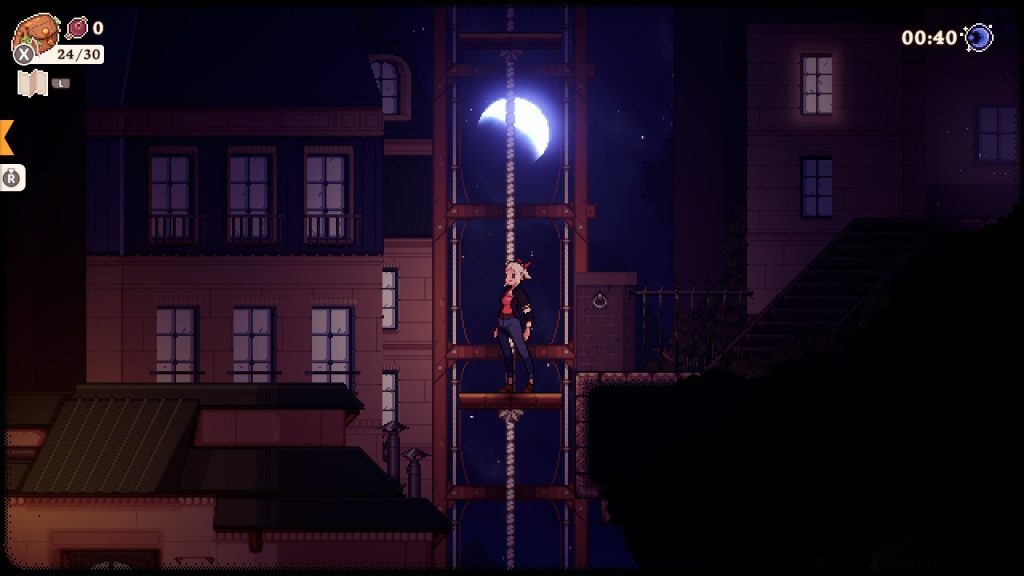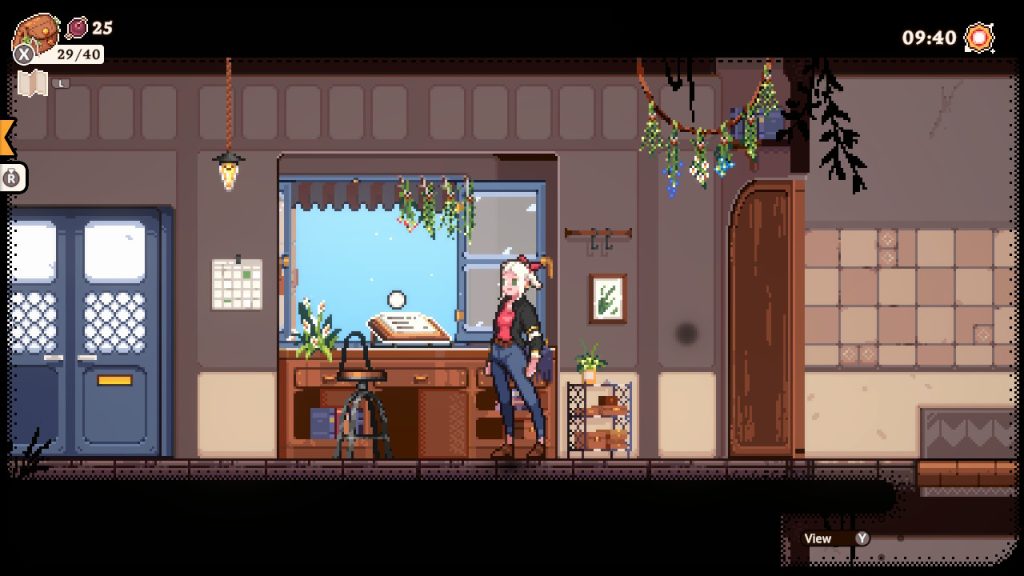Welcome to my Magical Delicacy review. We were not given a review code for this title.
- Buy Magical Delicacy on Steam
- Buy Magical Delicacy on Nintendo Switch
- Buy Magical Delicacy on Xbox
This review may contain minor spoilers for gameplay and story beats, though I always try not to reveal any major plot twists or surprises.
Magical Delicacy is a narrative-driven RPG with a liner crafting-based quest system couched in the story of a new-to-town witch named Flora trying to make a name for herself as Grat’s local chef. Billed as an exploration platformer, the game has players roaming a beautiful cityscape suspended in the sky where every footpath crosses chasms with tattered stone bridges and steampunk lifts.

Magical Delicacy’s story strays somewhat from the cooking/restaurant theme—after some deep exploration around the map, Flora will meet two other witches, seemingly in-conflict. One will gift her a dragon’s egg, which eventually hatches in her care. The mission thereafter is simple: find a way to sneak the dragon pup out of town and back to where it came from—The Wellspring. You’ll need to recruit some help along the way in the form of adventurers and a navigator, as well as gather some advice and equipment from experts around town.
The story and mechanics are somewhat at odds, as saving an orphaned dragon hatchling doesn’t inherently connect to cooking or running a business as a chef-witch. However, every step of the story hinges on a recipe request from one of the NPCs. They may ask for a specific type of food: soup, dessert, baked goods, tea, and so on. They may also have specific flavor preferences or preparation needs: don’t use spicy ingredients, make sure the end result has a sour profile, use an ingredient with the taste tag ‘sweet,’ include something juiced or enchanted. You get the picture.



With business sim-ing as a tangential byproduct of the currency system in Magical Delicacy, cozy gamers will spend the majority of their time foraging for recipes and resources to help the residents with various requests. Given a modest store with a soup pot and sink to start, players will navigate complex cooking mechanics to try and score a high enough star rating per cooked meal to earn a profit. From there, they can unlock more kitchen space, buy new utensils, start a small garden, and experiment with new recipes and flavor combinations.
When I say the cooking system is “complex,” I mean you’ll-probably-need-a-guide-for-it COMPLEX. Every flavor has a place in a complex 14-storey hierarchy where fowl overpowers spicy, spicy overpowers sour, sour beats bitter, bitter beats sweet, all the way down to the least effective flavors on the list: refreshing, delicate, insipid. If you use a bitter herb in a dish, for example, it will overpower any of the ingredient flavors that are considered a lower tier profile.
This needs to be taken into consideration for NPC requests, as they will often ask for a dish in a particular flavor. If they pick a weak flavor—something like delicate or insipid—you may need to use multiple ingredients with that quality in order to sway the dish in that direction. There are also flavors that cancel others out entirely: poisonous cancels out fowl, creamy cancels out spicy. This can be used to your advantage if you are trying to wrangle a particularly potent flavor in favor of a weaker one.



All that being said, experimenting with ingredients in the kitchen, deciding how much to sell them for, and slowly building out your shop is fun. But solving the puzzles behind each dish request is often cumbersome and convoluted. How do I make a max 5-ingrdient dish that isn’t a dessert, uses an enchanted ingredient, and is flavored earthy? What earthy herbs, crops, and vegetables do I have to choose from? Where can I find what I need in the shops around town or through foraging?
Because the village of Grat is made up on the platforming components of the game, going places isn’t easy. Many areas are linked by fast travel spots (once you unlock them) but getting anywhere outside of that system is time-consuming, repetitive, and often frustrating. Not many folks will enjoy platforming their way to the bakery for the fifteenth time in 1 gaming session. I found myself waiting around in an area for a full-day cycle just to avoid coming all the way back when a rare ingredient was set to restock.
The problem is made worse by the relatively limited inventory system, which has Flora only able to carry about 30-40 items at a time. This seems like a lot but having a stock of key ingredients on you—like 5 rock salts and 5 braided wheat, two staples—already hogs 1/4 of your pack. So going out for the day to shop and forage can often turn into several back-and-forths between the outside world and your storage at home.




All this is really too bad because the high fantasy world-building and moody pixel art atmosphere is easily the best part of the game. The first time I crossed the map, I was enthralled. It was awe-inspiring. Towering building carved into stone, woven together by stairs stitched into the earth or build out of wood. Scaffolding framed every scene, giving a sneak peek into how the luscious terrain of Grat is all held together. You can double jump, boost upward, and transform into a shadow to make your way to secret areas. You can buy a lift pass or unlock coven quick travel to find shortcuts. There are catacombs and sewers to be explored.
Honestly, if given full reign of Grat and the mission only to build out a witchy chef service, I would have had fun. So much fun. But it was the naggy, picky quest requirements that made traversing this stunning world a chore rather than a delight. The cookery was such a far, far after-thought that the “delicacy” part of the title really could have been something—anything—else. Magical Dragon Daycare, Magical Fetch Quests, Magical Backpack Management. The cooking really wasn’t the focus. It was more a combination of resource management, platforming, and puzzle solving to make the ingredients all fit the way they needed to every time.



As much as I love Grat, I felt like I couldn’t enjoy it. I was too busy racing across the map one way to find the builder’s shop only to turn around and race back across the map looking for a certain pale mushroom. If I wasn’t reviewing the game, I probably would have just given up. Sat back experimenting with recipes and selling them out the front window of my shop. Unlocking everything I could purchase. And then turning off the game for good without ever rolling credits.
I think that casual players will enjoy Magical Delicacy more for this reason. There’s no need to forge ahead with the main quest. You can enjoy your time discovering secrets and unlocking recipes. You can just stop and look at the scenery. You don’t need to scrawl on scrap paper your ideas for how to turn a soup refreshing or a cake insipid. You can just…create and combine and craft. You can improve the star ratings of your food and sell them for more money. You can expand your shop and set it up in just the way you like. You can meander from one corner of the map to the other, letting the answers to recipe puzzles come secondary to just enjoying your time within the world.
Magical Delicacy has so much potential, but the “game-ness” of it all gets in its own way.



Summary
Who reads video game reviews anymore? Here is the TLDR:
Pros
- Awe-inspiring immersive, atmospheric setting
- Unique blend of crafting x platforming mechanics
- Stunning pixel art characters and landscapes
Cons
- Cooking puzzles tend to be a challenge
- Lots of roaming back and forth across the map
- More inventory space desperately needed

Conclusion
Magical Delicacy is a narrative-driven RPG that combines elements of cooking, exploration, and puzzle-solving. The game centers around a witch named Flora, who aspires to become the local chef of Grat. While the game’s mechanics revolve around crafting complex dishes to fulfill NPC requests, the cooking system is intricate and often cumbersome, requiring players to navigate a convoluted hierarchy of flavors. Though the game’s stunning world-building and enchanting atmosphere offer a visually captivating experience, the demanding quests and platforming challenges can detract from the enjoyment. Casual players may find more pleasure in exploring and experimenting with recipes at their own pace, rather than being bogged down by the main quest.
I’d recommend buying Magical Delicacy at a steep discount if you are interested in trying it. Wishlist it on Steam and wait for a sale price of $10 or less. You really can lose yourself in this game, but the main quest line may not be the biggest draw.
Who Magical Delicacy is for…
- Fans of puzzle platformers + exploration genres
- Players who enjoy resource/inventory collection & management
- Gamers who like environmental storytelling and atmospheric settings
Who Magical Delicacy is not for…
- Folks looking for business sim elements to be a priority
- Players hoping for an easy, casual experience
Stay cozy, gamers!
You Might Also Like: Bandle Tale: A League of Legends Story
